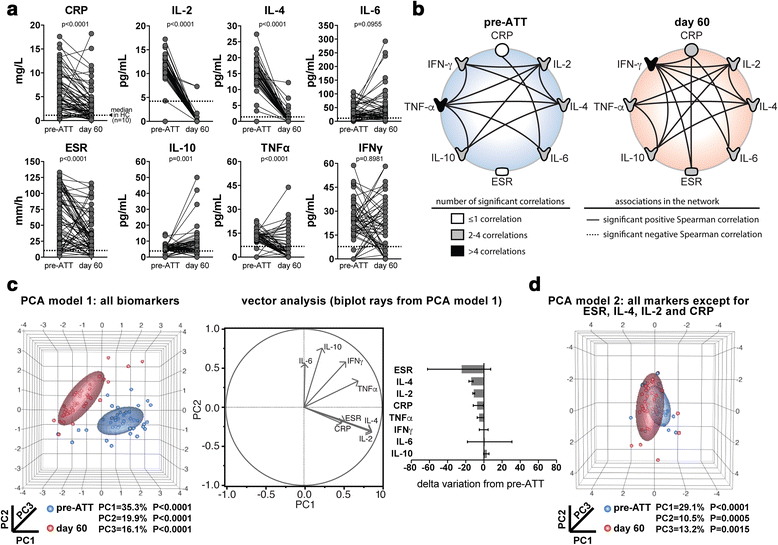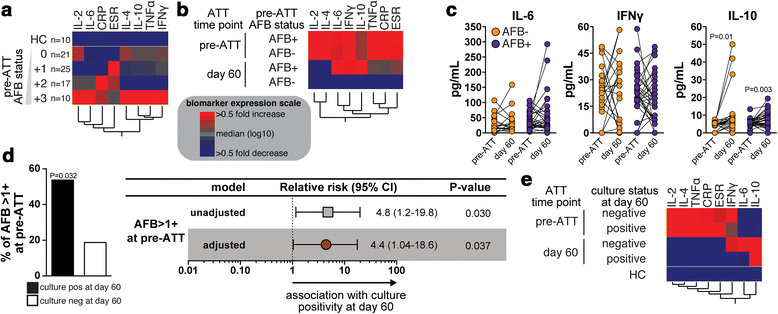Associations between systemic inflammation, mycobacterial loads in sputum and radiological improvement after treatment initiation in pulmonary TB patients from Brazil: a prospective cohort study
- PMID: 27494953
- PMCID: PMC4974760
- DOI: 10.1186/s12879-016-1736-3
Associations between systemic inflammation, mycobacterial loads in sputum and radiological improvement after treatment initiation in pulmonary TB patients from Brazil: a prospective cohort study
Abstract
Background: Mycobacterium tuberculosis infection is known to cause inflammation and lung tissue damage in high-risk populations. Nevertheless, direct associations between mycobacterial loads, systemic inflammation and pulmonary lesions upon treatment initiation have not been fully characterized. In the present exploratory study, we prospectively depict the immune profile, microbial clearance and evolution of radiographic lesions in a pulmonary tuberculosis (PTB) patient cohort before and 60 days after anti-tuberculous treatment (ATT) initiation.
Methods: Circulating levels of cytokines (IL-2, IL-4, IL-6, IL-10, IFN-γ, TNF-α) and C-reactive protein (CRP), as well as values of erythrocyte sedimentation rate (ESR) were measured in cryopreserved serum samples obtained from 73 PTB patients at pre-ATT and day 60 of treatment. Changes of the immune profile over time were compared with mycobacterial loads in sputum and culture conversion at day 60 of ATT. Additional analyses tested associations between improvement of chest radiographic lesions at day 60 and pre-treatment status of inflammation and mycobacterial loads.
Results: Within the inflammatory parameters evaluated, values of CRP, IL-2, IL-4, TNF-α and ESR significantly decreased upon treatment initiation. On the converse, IL-10 levels substantially increased at day 60 of ATT, whereas concentrations of IL-6 and IFN-γ remained unchanged. Multidimensional analyses revealed that ESR, IL-2, IL-4 and CRP were the parameters with the highest power to discriminate individuals before and after treatment initiation. We further demonstrated that higher bacterial loads in sputum at pre-ATT were associated with increased systemic inflammation and higher risk for positive M. tuberculosis sputum cultures at day 60 of treatment. Furthermore, we found that pre-ATT mycobacterial loads in sputum and systemic inflammation synergistically associated with the status of radiographic lesions during treatment (Relative risk for chest X-ray improvement: 10.0, 95 % confidence interval: 2.4-40.0, P = 0.002).
Conclusions: M. tuberculosis loads in sputum are directly associated to the status of systemic inflammation and potentially impact the immune profile, culture conversion and evolution of lung lesions upon ATT initiation.
Keywords: Acid-fast bacilli; Anti-tuberculous treatment; Biomarker; C-reactive protein; Erythrocyte sedimentation rate; Inflammation; Radiographic evaluation; Tuberculosis.
Figures




References
-
- Jenum S, Dhanasekaran S, Lodha R, Mukherjee A, Kumar Saini D, Singh S, Singh V, Medigeshi G, Haks MC, Ottenhoff TH, et al. Approaching a diagnostic point-of-care test for pediatric tuberculosis through evaluation of immune biomarkers across the clinical disease spectrum. Sci Rep. 2016;6:18520. doi: 10.1038/srep18520. - DOI - PMC - PubMed
-
- Kassa D, de Jager W, Gebremichael G, Alemayehu Y, Ran L, Fransen J, Wolday D, Messele T, Tegbaru B, Ottenhoff TH, et al. The effect of HIV coinfection, HAART and TB treatment on cytokine/chemokine responses to Mycobacterium tuberculosis (Mtb) antigens in active TB patients and latently Mtb infected individuals. Tuberculosis (Edinb) 2016;96:131–140. doi: 10.1016/j.tube.2015.05.015. - DOI - PubMed
MeSH terms
Substances
Grants and funding
LinkOut - more resources
Full Text Sources
Other Literature Sources
Research Materials
Miscellaneous

